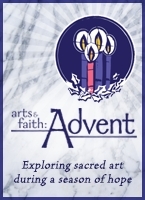Arts & Faith: Week 4 of Advent, Cycle B
John Collier, “The Annunciation,” 2000

John Collier’s contemporary depiction of the Annunciation brings the story of Mary’s encounter with the angel Gabriel into our present reality. Collier’s The Annunciation stands on the shoulders of Tradition, depicting the encounter in such a way that includes the standard symbols of the past. We see Mary and the angel face-to-face, Mary holding a book as a symbol of her piety. We see the lily as a symbol of her purity, the painted window as a symbol of her virginity, and the dove perching in the background as the symbol of the Holy Spirit. These symbols are the familiar language of many Annunciation scenes and connect this work to those from the great masters of the past.
While using these familiar elements, Collier retells the story for our present day: Mary is a young schoolgirl with a ponytail, still in her uniform, and she lives in a suburban neighborhood. Her shoes are playfully untied—she must have just slipped back into them to come to the door. In bringing together past and present, Collier invites us to see the Gospel scene not as a distant story but as one unfolding in our lives here and now.
As the story unfolds, the encounter between Mary and the angel reveals even deeper meaning. Mary is a young schoolgirl with untied shoelaces, but she is also a figure of strength, steadfastness, and faith. She looks squarely at the angel, who in contrast bows reverently before her, paying homage to God’s grace manifest in his lowly handmaid. The angel’s presence is subtly liturgical—in his dress and posture, he resembles an acolyte serving at the altar, ready to adore the presence of the Lord who will in a moment become flesh in the body of this young girl. The angel-as-server is a beautiful reflection of Christ’s bodily presence in our midst, first welcomed through the faithful “yes” of Mary. Standing at the door with Mary and Gabriel, we are at a liturgy, gathered into one Body to encounter the real presence of Christ in our midst. Like Mary, we are called to say “yes” to this moment and offer ourselves to await his arrival.

Commentary is by Daniella Zsupan-Jerome, director of ministerial formation at Saint John's University School of Theology and Seminary.
Related Ignatian reflection on this week’s art
The Annunciation by John Collier. Used with permission. All rights reserved. Hillstream.com
Week 4 of Advent, Cycle B

I Say Yes! (Ages 9–11)
Explain to children that Mary didn’t have to say “yes” to God, that she was scared and unsure but trusted her faith in God. Point out that by John Collier choosing to show Mary as a modern girl, he shows us that we can be like Mary in our lives. Have children draw a self-portrait. When finished, have children think about all the things they believe in and say “Yes!” to, such as family, education, dreams, exercise, friends, and God. Remind children that though some things are hard, we have faith that God will give us the strength we need to see us through. Encourage children to display their self-portraits in a place that will remind them of their faith and values.

